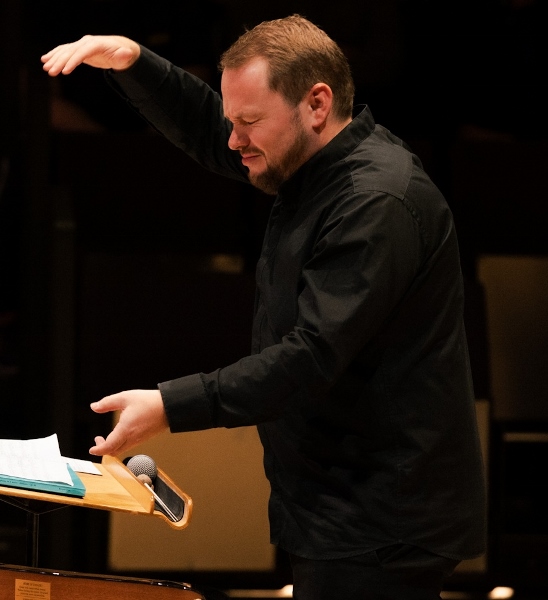Kohout, Spence, Braun, Manchester Camerata, Huth, RNCM, Manchester review - joy, insight, imagination and unanimity | reviews, news & interviews
Kohout, Spence, Braun, Manchester Camerata, Huth, RNCM, Manchester review - joy, insight, imagination and unanimity
Kohout, Spence, Braun, Manchester Camerata, Huth, RNCM, Manchester review - joy, insight, imagination and unanimity
Celebration of the past with stars of the future at the Royal Northern College

The Royal Northern College of Music was in celebratory mood last night for the opening of its new season, in a joint promotion with Manchester Camerata that marked the 50th anniversary of the start of the RNCM’s Junior Fellowship programme.
For Benjamin Huth, it was his final performance as the 2024/25 Mills Williams Junior Fellow in Conducting, and with him were three soloists moving on from their time on the RNCM International Artists Diploma, the highest performance accolade the college offers. What better way for a violinist, cellist and pianist to celebrate together than in Beethoven’s Triple Concerto?
There was a sense of joy in the music-making that the RNCM fosters so well, and the concerto performance itself was marked by insight, imagination and unanimity that are rare in the busy world of music-making and, I guess, stem from the experience of study in the collegiate setting.
Huth and the Camerata, led by Bradley Creswick, began with a bit of fun in the shape of Caroline Shaw’s Entr’acte: A Minuet & Trio. It’s a re-shaping of ideas from the second movement of Haydn’s last string quartet: if he could do a few cute things with a minuet there, it seems she decided, she could do a whole lot more with the concept. There were times when his pure classical harmony was warmly created, but they never lasted long before the piece goes cheerfully off-piste, with some jolly leaps and bumps, ingenious effects such as near-soundless bowing and finger-board pizzicato, a weird excursion to make the transition to the opening’s return, and finally a pizzicato solo in cadenza style for the principal cello, Hannah Roberts – after which it’s all over.
The Beethoven, though, was both more serious and more uplifting. Krystof Kohout (violin), Findlay Spence (cello) and Susanna Braun (piano), were playing as if controlled by a single mind, with a delightfully varied range of tone from each of them contributing to the sound palette of the solo group. The string players began with some ferocity, and intensity was never far away, while the piano sound flowed and sparkled alongside them.
 The concerto is a fusion of two different, full-compass sound worlds, one the piano trio and the other the classical orchestra, and the constant variety of textures it offers is its chief delight, fully realized in this performance. The first movement development brought a sequence of moods, from awe through anxiety to relaxation, in a mini-drama of its own, and its final bars were rapped out with gusto. The slow movement brought sweet cantabile from Findlay Spence’s cello solo, and a lovely, self-effacing subtlety from Krystof Kohout’s violin melody, and a clever handling of the transition to the attacca finale. Here there were brilliance and touches of humour, ringing high notes from Susanna Braun’s piano, and an enthusiasm which, with Benjamin Huth’s assistance, was shared by the orchestra. They hit a rumbustious, almost swaggering style before the helter-skelter Presto, the soloists still revealing moments of amazing gentleness before the end. I heard each of these three IAD performers in their solo showcase concerts with the BBC Philharmonic in June, and each has surely far to go in their careers from now on. It was an inspiration to witness them making music together.
The concerto is a fusion of two different, full-compass sound worlds, one the piano trio and the other the classical orchestra, and the constant variety of textures it offers is its chief delight, fully realized in this performance. The first movement development brought a sequence of moods, from awe through anxiety to relaxation, in a mini-drama of its own, and its final bars were rapped out with gusto. The slow movement brought sweet cantabile from Findlay Spence’s cello solo, and a lovely, self-effacing subtlety from Krystof Kohout’s violin melody, and a clever handling of the transition to the attacca finale. Here there were brilliance and touches of humour, ringing high notes from Susanna Braun’s piano, and an enthusiasm which, with Benjamin Huth’s assistance, was shared by the orchestra. They hit a rumbustious, almost swaggering style before the helter-skelter Presto, the soloists still revealing moments of amazing gentleness before the end. I heard each of these three IAD performers in their solo showcase concerts with the BBC Philharmonic in June, and each has surely far to go in their careers from now on. It was an inspiration to witness them making music together.
Rejoicing continued in the performance of Mendelssohn’s “Italian” Symphony, No. 4. Under Benjamin Huth’s unobtrusive direction (pictured above) it was alive and alert from the start, the brass punctuations of the textures pointed and effective and the string articulation clean and varied in dynamic. Rachael Clegg’s oboe solo made the transition to the first movement’s recapitulation memorable, and the bouncy fresh theme from the development that dominates the coda was given its own extra impetus. Not one to hang about, Huth’s pace for the Pilgrim’s Song second movement was that of a pretty brisk Nordic walking bass, but the hymn above it was all the more flowing, and its close beautifully faded. There was a nice contrast in the third movement between its graceful principal theme and perky trio, and the finale, called a Saltarello and ultimately racing like a tarantella, was played with elegant precision, stemming from Amina Hussain’s principal flute’s lead, and built to an exciting climax.
rating
Share this article
The future of Arts Journalism
You can stop theartsdesk.com closing!
We urgently need financing to survive. Our fundraising drive has thus far raised £49,000 but we need to reach £100,000 or we will be forced to close. Please contribute here: https://gofund.me/c3f6033d
And if you can forward this information to anyone who might assist, we’d be grateful.

Subscribe to theartsdesk.com
Thank you for continuing to read our work on theartsdesk.com. For unlimited access to every article in its entirety, including our archive of more than 15,000 pieces, we're asking for £5 per month or £40 per year. We feel it's a very good deal, and hope you do too.
To take a subscription now simply click here.
And if you're looking for that extra gift for a friend or family member, why not treat them to a theartsdesk.com gift subscription?
more Classical music
 Kohout, Spence, Braun, Manchester Camerata, Huth, RNCM, Manchester review - joy, insight, imagination and unanimity
Celebration of the past with stars of the future at the Royal Northern College
Kohout, Spence, Braun, Manchester Camerata, Huth, RNCM, Manchester review - joy, insight, imagination and unanimity
Celebration of the past with stars of the future at the Royal Northern College
 Jansen, LSO, Pappano, Barbican review - profound and bracing emotional workouts
Great soloist, conductor and orchestra take Britten and Shostakovich to the edge
Jansen, LSO, Pappano, Barbican review - profound and bracing emotional workouts
Great soloist, conductor and orchestra take Britten and Shostakovich to the edge
 Jakub Hrůša and Friends in Concert, Royal Opera review - fleshcreep in two uneven halves
Bartók kept short, and a sprawling Dvořák choral ballad done as well as it could be
Jakub Hrůša and Friends in Concert, Royal Opera review - fleshcreep in two uneven halves
Bartók kept short, and a sprawling Dvořák choral ballad done as well as it could be
 Hadelich, BBC Philharmonic, Storgårds, Bridgewater Hall, Manchester review - youth, fate and pain
Prokofiev in the hands of a fine violinist has surely never sounded better
Hadelich, BBC Philharmonic, Storgårds, Bridgewater Hall, Manchester review - youth, fate and pain
Prokofiev in the hands of a fine violinist has surely never sounded better
 Monteverdi Choir, ORR, Heras-Casado, St Martin-in-the-Fields review - flames of joy and sorrow
First-rate soloists, choir and orchestra unite in a blazing Mozart Requiem
Monteverdi Choir, ORR, Heras-Casado, St Martin-in-the-Fields review - flames of joy and sorrow
First-rate soloists, choir and orchestra unite in a blazing Mozart Requiem
 Cho, LSO, Pappano, Barbican review - finely-focused stormy weather
Chameleonic Seong-Jin Cho is a match for the fine-tuning of the LSO’s Chief Conductor
Cho, LSO, Pappano, Barbican review - finely-focused stormy weather
Chameleonic Seong-Jin Cho is a match for the fine-tuning of the LSO’s Chief Conductor
 Classical CDs: Shrouds, silhouettes and superstition
Cello concertos, choral collections and a stunning tribute to a contemporary giant
Classical CDs: Shrouds, silhouettes and superstition
Cello concertos, choral collections and a stunning tribute to a contemporary giant
 Appl, Levickis, Wigmore Hall review - fun to the fore in cabaret and show songs
A relaxed evening of light-hearted fare, with the accordion offering unusual colours
Appl, Levickis, Wigmore Hall review - fun to the fore in cabaret and show songs
A relaxed evening of light-hearted fare, with the accordion offering unusual colours
 Lammermuir Festival 2025, Part 2 review - from the soaringly sublime to the zoologically ridiculous
Bigger than ever, and the quality remains astonishingly high
Lammermuir Festival 2025, Part 2 review - from the soaringly sublime to the zoologically ridiculous
Bigger than ever, and the quality remains astonishingly high
 BBC Proms: Ehnes, Sinfonia of London, Wilson review - aspects of love
Sensuous Ravel, and bittersweet Bernstein, on an amorous evening
BBC Proms: Ehnes, Sinfonia of London, Wilson review - aspects of love
Sensuous Ravel, and bittersweet Bernstein, on an amorous evening
 Presteigne Festival 2025 review - new music is centre stage in the Welsh Marches
Music by 30 living composers, with Eleanor Alberga topping the bill
Presteigne Festival 2025 review - new music is centre stage in the Welsh Marches
Music by 30 living composers, with Eleanor Alberga topping the bill
 Lammermuir Festival 2025 review - music with soul from the heart of East Lothian
Baroque splendour, and chamber-ensemble drama, amid history-haunted lands
Lammermuir Festival 2025 review - music with soul from the heart of East Lothian
Baroque splendour, and chamber-ensemble drama, amid history-haunted lands

Add comment